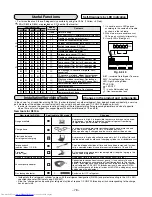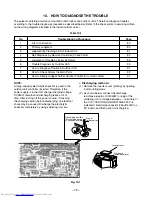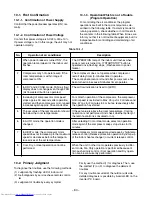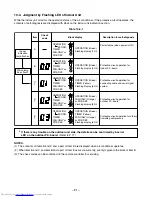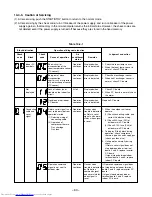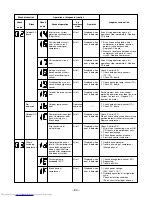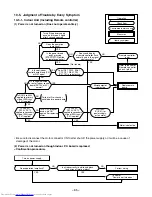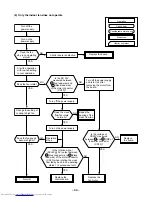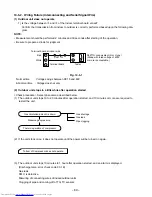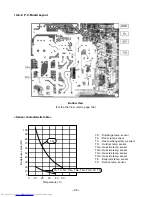
– 91 –
Replace
outdoor
fan motor.
Remove
connector of
compressor.
NG
NG
NG
NO
NO
OK
OK
OK
YES
YES
Check 30A fuse
(Part No.F01).
Does outdoor
fan rotate?
Replace fuse.
Check
electrolytic
capacitor, diode
block, etc.
Check
electrolytic
capacitor, diode
block, etc.
Remove connector
CN300 of outdoor fan
motor, and using a
tester, check resistance
value between every
phases at motor side.
Check
terminal voltage
of electrolytic
capacitor.
Does LED on control
board flash or go on?
C
B
A
Discharging position
(Discharging period
10 seconds or more)
Plug of
soldering
iron
10-7. How to Diagnose Trouble in Outdoor Unit
10-7-1. Summarized Inner Diagnosis of Inverter Assembly
Diagnosis/Process flowchart
Item
Preparation
Check
Contents
Turn “OFF” the power
breaker, and remove 3P
connector which connects
inverter and compressor.
• Check whether 30A fuse on
the control board assembly
is blown or not. (F01)
Operation
Measurement
Check
Stop
Check
Measurement
Turn on power breaker, and
operate the air conditioner in
COOL mode by short-circuit
of the timer.
Measure terminal voltage of
the electrolytic capacity.
760µF:400WV x 4
After operation, turn off the
power breaker after 2 minutes
20 seconds passed, and
discharge the electrolytic
capacity by soldering iron.
Check voltage between motor
phases.
• Is not winding between
Q
–
R
,
R
–
S
, or
Q
–
S
opened or short-circuited?
• Is not frame grounded with
Q
,
R
, or
S
?
Summary
If fuse was blown, be sure to
check the electrolytic
capacitor and diode block.
(DB01)
• Connect discharge resis-
tance (approx. 100
Ω
40W)
or soldering iron (plug)
b, – terminals of
the electrolytic capacitor
(760µF) of C13 (with
printed CAUTION HIGH
VOLTAGE) on P.C. board.
OK if 760µF
→
DC280V
Remove CN300 while
pushing the part indicated by
an arrow.
→
Resistance between
phases should be approx.
25 to 55
Ω
.
→
Should be 10M
Ω
or more.


